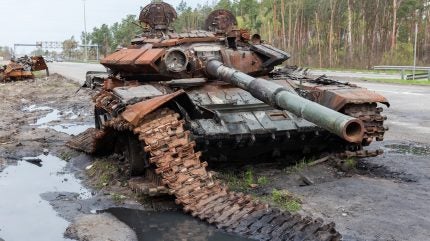
Russian military casualties in Ukraine in February saw the highest single-month losses sustained since Russia’s large-scale invasion of its neighbour more than two years ago, according to the latest estimates.
Last month saw Russia finally seize Avdiivka in eastern Ukraine following several weeks of bloody urban combat, while other advances across the eastern and southern fronts also sought to exploit the failure of Ukrainian forces to achieve a significant breakthrough in the late-2023 offensive.
It is estimated that Russian forces sustained an average of 983 battlefield casualties per day in Ukraine throughout February, or more than 28,000 over the course of the month.
A battlefield casualty refers to personnel that are either killed or injured on operations, and thus taken off the frontline. A rough ratio in contemporary warfare suggests that for every soldier killed in action, there are a further two-to-three personnel injured.
Using this ratio, up to 10,000 Russian military personnel could have been killed in Ukraine in February.
Russian tactics appear to favour heavy artillery and long-range fires support to soften a target area, which is then assaulted using infantry. The estimates of Russian losses in February are around double the monthly average, which stands at around 14,000 per month.
Russia-Ukraine military casualties mounting as combat continues
By the two-year anniversary of Russia’s invasion of Ukraine, which began on 24 February 2022, Russian military casualties were up to 350,000, according to estimates.
However, Russia retains the ability to replenish battlefield losses in personnel and materiel, with partial mobilisation campaigns enacted by Moscow to draw in new recruits to fill the gaps created as units are reconstituted following their time on the frontline.
In February 2024, Ukrainian President Volodymyr Zelensky said that 31,000 Ukrainian military personnel had been killed during the war.
Since seizing Avdiivka in February, Russian forces have pushed westwards beyond Marinka, while maintaining further attacks across the east and south of the Ukraine. However, the average number of weekly attacks has reduced by 13% since mid-February, when the weekly average reached 600.
In addition, across much of occupied Ukraine, election booths have opened early for Russia’s Presidential Elections, the result of which will see President Vladimir Putin win another term in office.
The occupied areas of Ukraine were annexed by Russia in 2023, a decision which was not recognised by the Western World. However, Russia is persisting with a process of Russification of seized Ukrainian populations, which amount to some 2.6m people or 6% of the country’s pre-war population.
Russia achieved 80% success rate in countering Ukrainian drone threats
Meanwhile, the development of combat operations in Ukraine has seen a rapid evolution in combat tactics and technology, despite the prevailing World War 1-style human wave assaults by much of Russia’s military.
Chief among the developments has been the use of small one-way attack drones, effectively small commercial drones fitted with an explosive device, as a capability used to track and target infantry and armoued vehicles caught in the open. Social media channels are filled with examples from both sides of commercial-grade one-way attack munitions, using so-called first-person-view (FPV) drones, striking at military targets.
Ukraine is known to be development a significant stockpile of such munitions, with the UK also recently announcing that it would help supply 10,000 drones to Kyiv, including 1,000 FPV “attack drones”, the UK Government stated on 7 March.
However, Russia is understood to have a sophisticated electronic warfare (EW) capability at the tactical and strategic level and is able, to some degree, to counter the use of FPV attack drones.
Speaking during a recent panel discussion at the Center for Security and International Studies, the Chief of the British Army’s General Staff, General Patrick Sanders, stated that Russian successes in using its EW capabilities to counter Ukrainian drones was “during one period, recently” at around 80%.
Sanders attributed this to the current state of the battlefield’s “extraordinarily contested electromagnetic spectrum” and Russia’s “effective use” of its EW capabilities.







